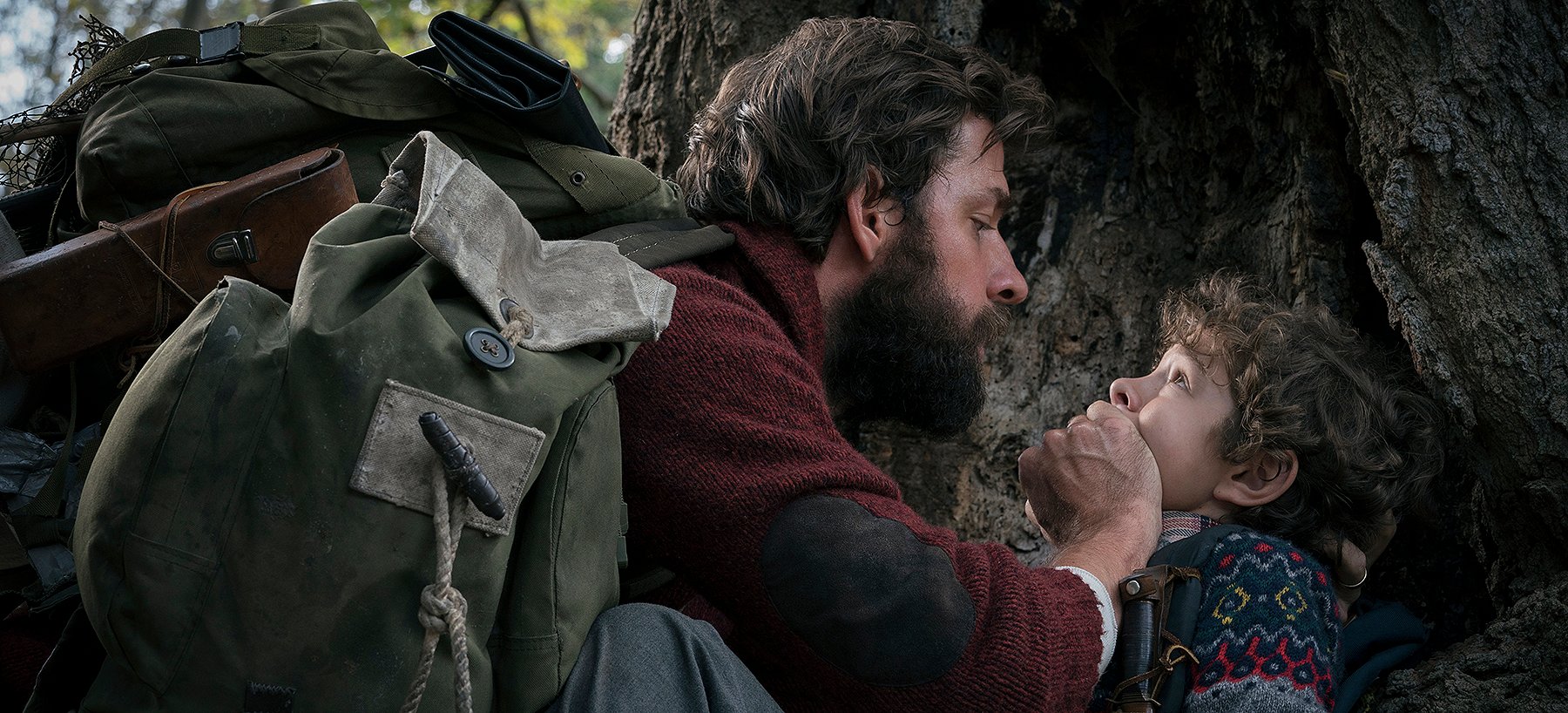
Don’t Speak: A Quiet Place
Cinematographer Charlotte Bruus Christensen mixes anamorphic and spherical lenses on John Krasinski’s film-captured horror project.
Cinematographer Charlotte Bruus Christensen mixes anamorphic and spherical lenses on John Krasinski’s film-captured horror project.
By Jean Oppenheimer
Unit photography by Jonny Cournoyer, courtesy of Paramount Pictures.
Kicking off this year’s South by Southwest Film Festival was A Quiet Place, a contemporary horror-thriller about an ordinary family that must live in silence in order to elude mysterious creatures that hunt their human prey by sound. While the supernatural is a key element in the story, the film’s primary focus is the family and how they try to maintain as normal a life as possible while confronting an existential threat.
“We created images that sound designers could give a proper sound to, so viewers feel they are right there.”
Lee Abbott (John Krasinski, who also directed and co-wrote the film); his wife, Evelyn (Emily Blunt); and their two kids, Regan (Millicent Simmonds) and Marcus (Noah Jupe), live on a farm in upstate New York. “It was important to John that we create a realistic, truthful world — a recognizable environment and a believable family with whom audiences can identify — and then, within that, to have a genre movie,” offers cinematographer Charlotte Bruus Christensen, speaking to AC from her home in Copenhagen.
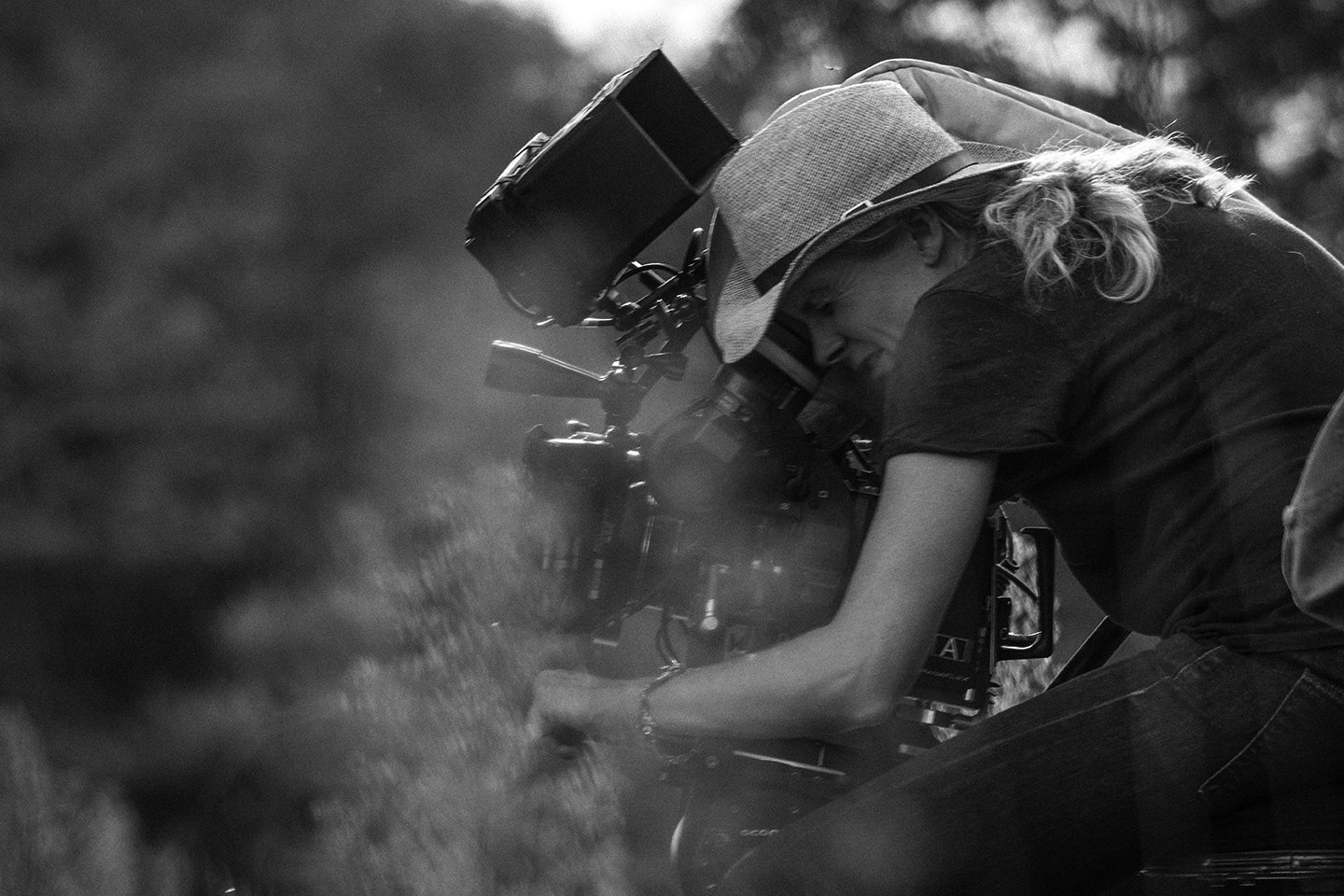
“The entire film focuses on this one family,” she continues. “The only way they know [that other people are still alive] is that every night Lee sets a fire atop the grain silo and, in response, fires appear on other silos around the countryside.” The family converses in American Sign Language, a normal form of communication for them because teenaged daughter Regan is deaf.
Visuals and sound effects do the heavy lifting in a film containing few spoken words. “That was our starting point in terms of the visual style,” says Christensen, known for her work on Far From the Madding Crowd (AC June 2015), Fences (AC Jan. ’17) and Molly’s Game. “We created images that sound designers could give a proper sound to, so viewers feel they are right there.” That translated into a lot of tight close-ups — pieces being moved on a Monopoly board, bare feet stepping gingerly. “If you are far away on a long lens, it wouldn’t be realistic to hear subtle sounds; if you get physically close to a character or object, even faint noises would become audible. It became our way of ‘photographing sound.’ It was also the impetus behind mixing anamorphic and spherical lenses.”
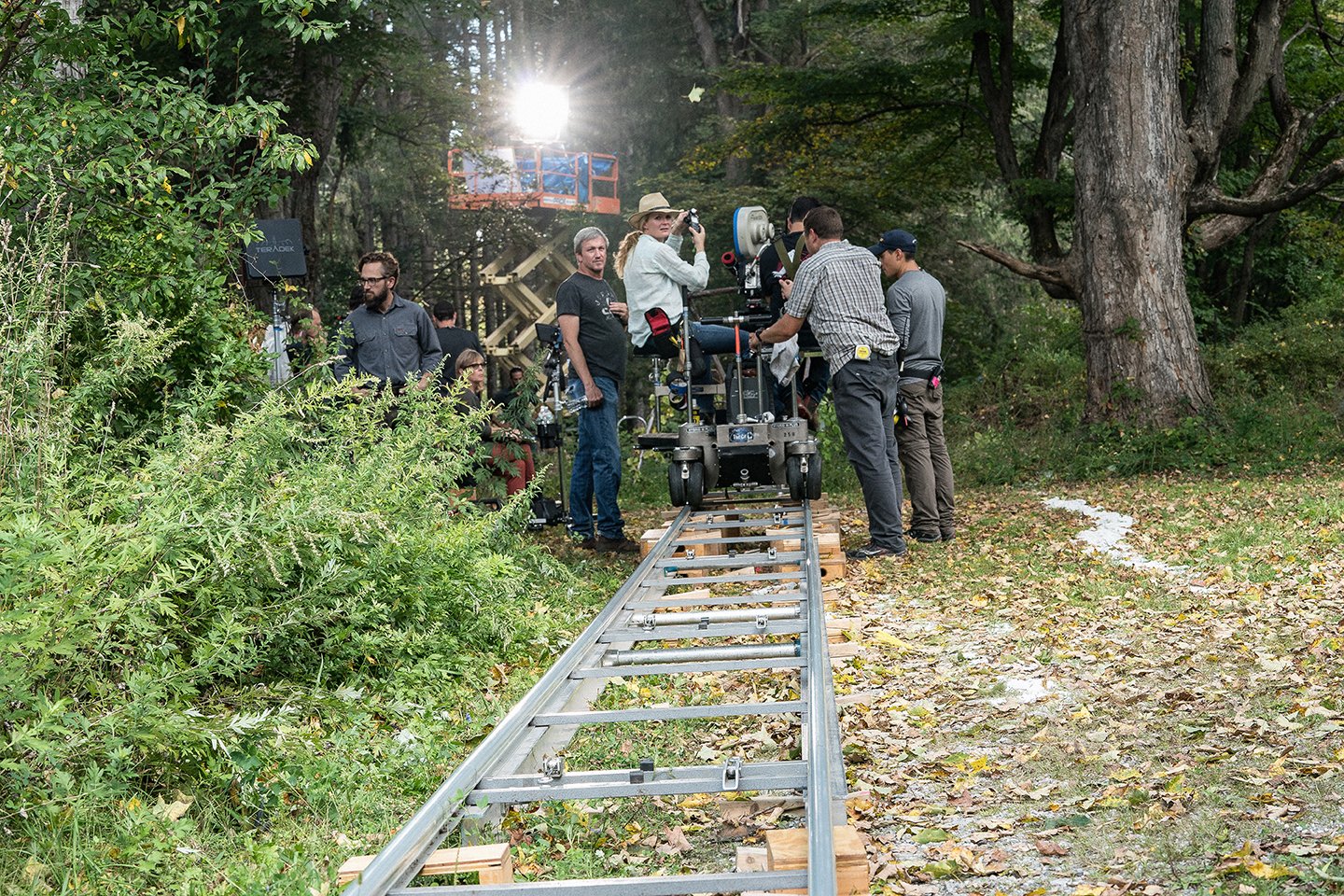
A Quiet Place was shot on 35mm film and released in 2.39:1. Anamorphic lenses captured the scale and beauty of daytime exteriors for the film — which was shot almost entirely on practical locations in New York State’s bucolic Dutchess County — as well as larger interior spaces, such as the barn that serves as the family’s living quarters. Spherical lenses were employed primarily for night exteriors, as well as some night interiors “when we needed the physical closeness,” Christensen says.
“Charlotte and I talked about [the format] at great length. She asked me what I wanted most out of the film, and I said, ‘to have a timeless quality, a sort of nostalgic quality that will take audiences back to a [particular kind of film].’”
“Anamorphic became our kind of ordinary, everyday look for scenes of the family eating meals and [going about their daily tasks],” she continues. “We used the 65mm C Series lens [with 15" minimum focus] a lot when we needed to get close on anamorphic.” But there was another look that was reserved for Regan in certain instances when “we needed to move into Regan’s mind and ‘hear’ her own silence.” To set her apart at these moments, Christensen — who operated A camera and handled the special shots of the girl — switched to a spherical 55mm lens and moved in tight on her. “We shot handheld for other scenes, but we wanted a specific handheld closeness for Regan, as if we are going inside her head.” First AC Stanley Fernandez Jr. reports that this lens was a 55mm Super Speed (T1.1) with a close focus of 2'. “It’s a Panavision lens housing with Zeiss glass in it,” he says.
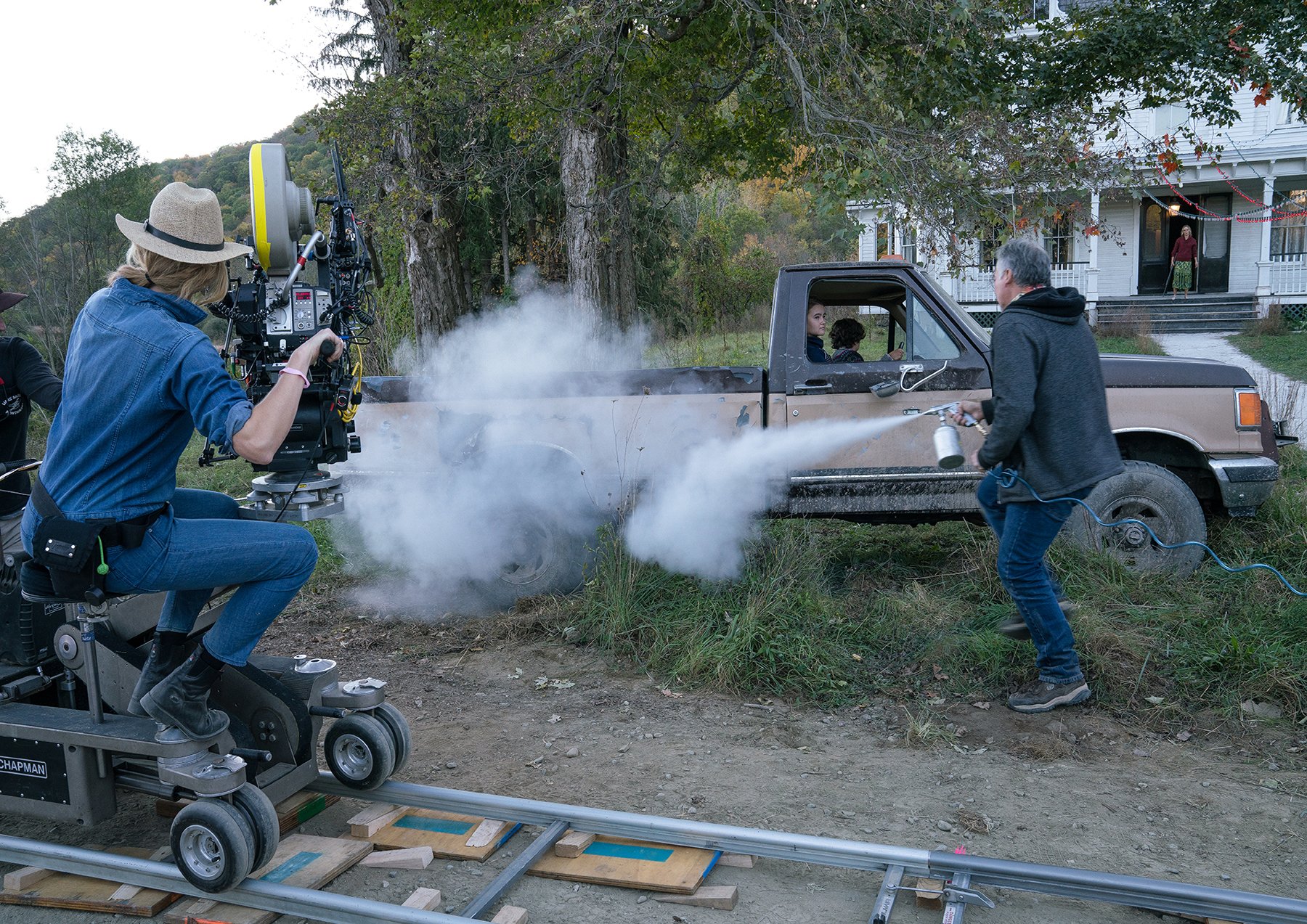
According to Krasinski, Regan’s POV plays an important role in the story. To further convey her sense of separation, the audio track changes. “Sound doesn’t go out completely,” the director says, “but we bring the audience into her head so you are hearing the world that she hears.” Diopters came into play for insert shots of her hearing aid.
Krasinski, who spoke to AC by phone from Austin, where the film had premiered the previous evening, credits Christensen not only with the idea of shooting on film, but also for suggesting the mix of spherical and anamorphic lenses. “Charlotte and I talked about [the format] at great length,” he remarks. “She asked me what I wanted most out of the film, and I said, ‘to have a timeless quality, a sort of nostalgic quality that will take audiences back to a [particular kind of film].’” His cinematic references were indicative of the kind of movie he had in mind.
“The storytelling narrative I wanted had a kind of Western quality to it. It had to do with the outdoors and wide shots, which play so well in both of those pictures.”
A key reference was Jaws (AC March ’75). Christensen explains, “In part, it was the way the story was built — not showing the giant shark until the end of the movie. You only see flashes of him earlier. But it was also Jaws’ mix and balance between the real world and a very genre movie. The Swedish film Let the Right One In (AC Dec. ’08) was another reference — again, you set up a realistic, truthful environment but within that you have a vampire movie.”
Other cinematic references were No Country for Old Men (AC Oct. ’07) and There Will Be Blood (AC Jan. ’08). Krasinski remarks, “The storytelling narrative I wanted had a kind of Western quality to it. It had to do with the outdoors and wide shots, which play so well in both of those pictures. It was Charlotte who pointed out that most of the films I was talking about had been shot on film.”
Christensen thought the medium was a good fit for A Quiet Place, giving it the old-fashioned cinematic look Krasinski envisioned — but it was a big decision because the story called for a fair number of visual effects. “We asked Industrial Light & Magic visual-effects supervisor Scott Farrar [ASC] whether he anticipated any problems, and he said ‘no,’” Christensen notes. “I learned so much from Scott about shooting creature work. He advised me how to move the camera when you can’t see what the creature is going to do, and how, if I moved the camera a little bit here or there, then visual effects could use that movement to create the creature within that space.”
She chose three Kodak Vision3 stocks: 500T 5219 for night work, 50D 5203 for day exteriors, and 250D 5207 for day interiors and overcast day exteriors. The film was shot in late summer on a challenging 30-day schedule. The film was processed at FotoKem. The dailies were completed at Technicolor New York by “the amazing John Vladic,” Christensen enthuses. The final color grade was performed at Company 3 in New York by senior colorist and ASC associate Stefan Sonnenfeld, who used Blackmagic Design’s DaVinci Resolve 14. It was Christensen’s first experience at Company 3, and she reports being exceedingly happy with the results.
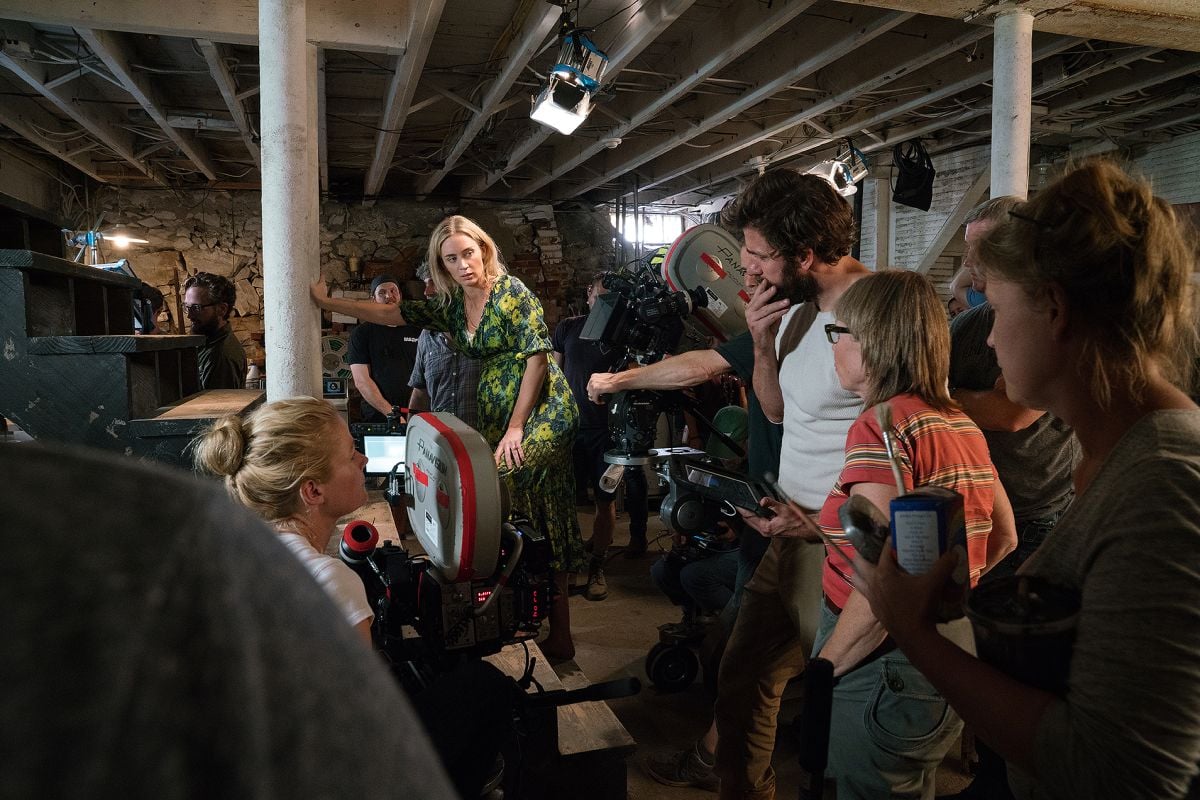
Panavision Woodland Hills supplied the camera gear: three Panavision Millennium XL2s — one body remained on the Steadicam — an Arriflex 235 and an old Arriflex IIC, the latter of which Christensen kept in the trunk of her car and pulled out whenever she ran across pretty sunrises, sunsets or nature shots on her way to and from work. The varied lens package included Panavision’s C, G and T Series anamorphic primes; a range of spherical primes comprised mostly of Super Speeds and a few wider-angle vintage lenses; Angenieux Optimo spherical zooms (15-40mm [T2.6], 28-76mm [T2.6], 28-340mm [T3.2] and 24-290mm [T2.8]); Panavision anamorphic zooms (40-80mm [T2.8] wide-angle AWZ2, 70-200mm [T3.5] telephoto ATZ, 270-840mm [T4.5] converted from an ALZ3, and 42-425mm [T4.5] ALZ10); anamorphic and spherical macro lenses; diopters; and several specialized lenses custom made by ASC associate Dan Sasaki, Panavision’s vice president of optical engineering. (See sidebar, below.)
“Even when we were shooting anamorphic, we liked to get close to characters as well as objects.”
Regarding the macro lenses, Sasaki explains, “The anamorphic macros were comprised of custom close-focus C Series, and 150mm and 200mm [Macro Panatars]. The spherical macros consisted of 50mm, 100mm and 125mm macro Sphero 65 lenses converted for use on 35mm cameras. A mini-periscope assisted with the macro capability of the lenses, especially with the very close POV shots.”
Early on, Christensen made a trip to the Los Angeles facility to prep the lenses with Sasaki. Describing the benefits of the mini-periscope, she notes, “It allowed us to actually lie on the floor with the kids as they played Monopoly. With most periscopes you have to shoot T5.6 or T8, but the mini that Dan crafted was a T1.9 — very light sensitive. We were shooting right across the floor. We were so close to the game board that you believe the sound that’s heard when the little [game] pieces are moved.”
Fernandez adds, “Sasaki designed the mini-periscope with no stop loss. He built it with a right-angle view and we put the camera on baby legs. [For one particular shot] we started tight as Marcus rolls the dice and slowly pulled back on the dolly.”
Another specialty lens made by Sasaki was a customized “100mm slant portrait lens for an effect,” Sasaki describes. “It had a sharp center with horizontally biased defocus on the edges that the operator could control.”
When it came to the film’s more conventional sequences, Christensen favored the Panavision C Series, but she and Sasaki discussed sharpening them a bit — “we wanted soft but not super-soft,” she says — and to change the minimum focus on some of them to get even closer. Sasaki then softened up the Ts to make them match the C Series. “Some of the Ts had a closer focus range that worked really well for us,” says Christensen. “Even when we were shooting anamorphic, we liked to get close to characters as well as objects.” Using Krasinski’s reference films as a template, she aimed for sharp images but cinematic texture — colorful, rounded, filmic.
The director also wanted a warm look for the film. “He wanted to feel the warmth within the family, to sense the bond between them,” Christensen says. “Creating a warm, candlelit environment adds to the understanding of a loving family. Even though the story expresses some deep frustration within and between the characters’ relationships, the tension is ignited from love.”
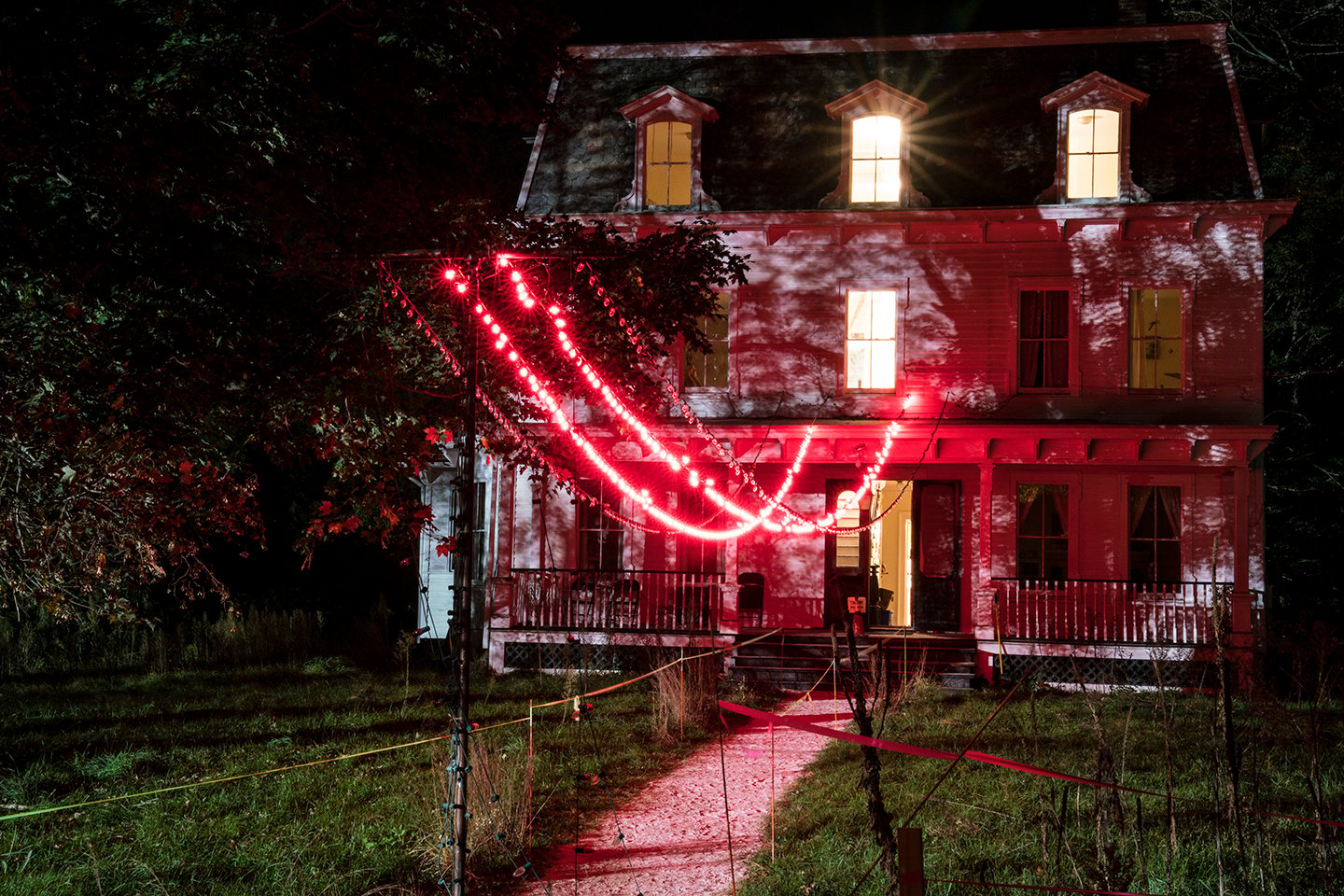
Long strings of onscreen “Christmas lights,” as Krasinski calls them, were an important visual element in A Quiet Place. For example, they crisscrossed the interior of the barn, where they stretch from one end to the other. The strings held hundreds of bulbs; some strands consisted of white bulbs, while others had red. The whites, which were clear 40-watt household bulbs, were dimmed down for a warm look and feel. The reds were clear-red 25-watt household-type bulbs augmented with Lee Filters 106 Primary Red gels. Gaffer Bill Almeida notes, “We used small Arri 650-watt and 1K tungsten lights with Lee 106 gel to augment the 25-watt red clear bulbs when we needed a bit more exposure with red light.”
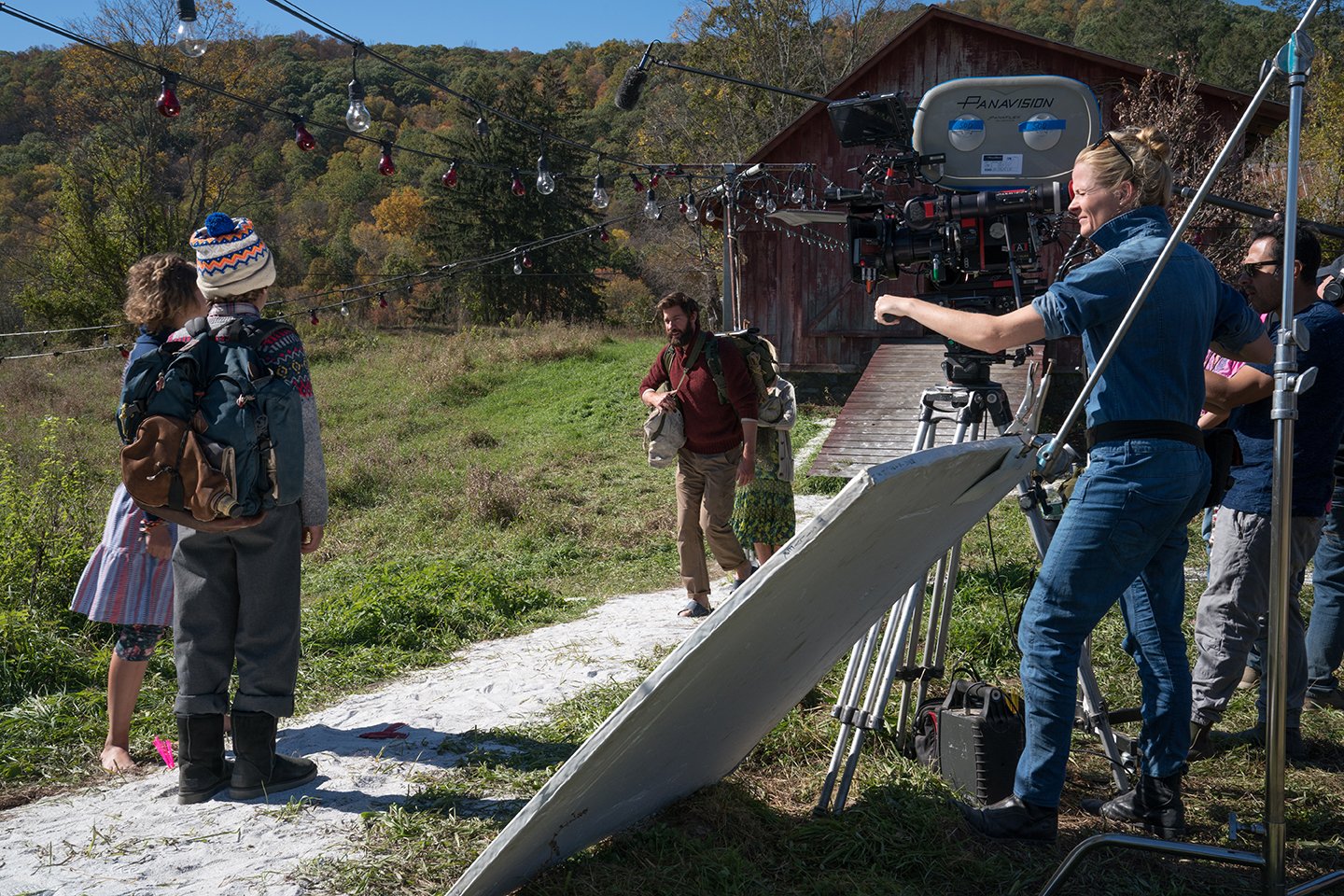
In addition to providing illumination for the family, the stringed bulbs are part of a communications system Lee has devised. “The white lights signify safety, and the red ones danger,” says Almeida. “They get switched on in the second half of the movie when things start to get tense. The different colored strands were hung parallel to one another and ran not only through the barn but also outside. At night the white lights illuminated the various sand paths that Lee had laid down to allow the family access to different areas of the farm.
“The family itself is a main character in the movie — as a unit, not as individuals. That was very important to me: when they feel like a family and when they feel more separate.”
“We also created a flickering effect that occurred whenever the creatures were in the vicinity,” Almeida continues. “The pulsating bulbs were caused by the creatures themselves — some sort of electro-magnetic interference they put out.”
To boost exposure, Almeida and his team hung a combination of Jem Balls, Chinese lanterns, Lowel Rifas and Chimeras from the ceiling — out of sight but close to the practicals. “We warmed up the tungsten lamps with CTS, rather than CTO,” Christensen says. Practical lamps were scattered throughout the barn interior as well.
In addition to the indoor lighting, units were set up outside the barn to create sun and moonlight through the windows. “The barn had seven or eight windows along each side, and there was a large door on both ends,” Almeida recalls. “For day scenes, we picked one side of the barn to be the sunny side and used Arri M40 HMIs; sometimes we went with hard light, and sometimes we put Lee 250 on 4' by 4' frames to soften them a bit. The windows on the opposite wall became our ‘fill’ side, and we used Arri M18s through diffusion, usually [Opal]. We placed 18Ks outside the barn’s two big doors as well. For night scenes, we employed Arri SkyPanel 60s to create a moonlit glow through the windows. We dialed in a blue to get the feel we wanted.”
According to Almeida, many of the day exteriors were also lit. “Sometimes we used a 20K tungsten Fresnel or Maxi-Brutes to create warm splashes of sunlight in the background, or as edge on the actors. At other times we went with two Arrimax 18K PARs with 1⁄2 CTO on condors.” Arri Rental in New York provided the lighting equipment for the production.
Some 50 to 60 percent of the film was shot using two cameras; the more intimate scenes relied on a single camera. A scene of the family eating at the dinner table was shot on a single circular track, with A and B cameras on different dollies. The A camera captured the tight shots on each character, while B camera was right next to it, handling the wider shots. “The family itself is a main character in the movie — as a unit, not as individuals,” Krasinki says. “That was very important to me: when they feel like a family and when they feel more separate. The wider lens captured the family as a whole, while the closer lens showed them as individuals.”
Christensen notes that Krasinski wanted the film to have a sense of nearly constant movement. “Even the wider establishing shots included subtle moves to make everything feel slightly unsettled and to create a hint of claustrophobia,” she says.

The biggest setup in the movie takes place at night in one of the cornfields. Family members are scattered across the farm, trying to locate one another but unable to shout out. A terrified Marcus, his flashlight bouncing wildly, runs through tall rows of corn that tower over him. David Emmerichs, who served as Steadicam/B-camera operator and 2nd-unit director of photography, donned safety goggles, grabbed the stripped-down Arriflex 235 fitted with a 40mm Super Speed, raised it to chest level, and charged after the boy. He operated off a video monitor attached to a shoulder strap. “That running shot was achieved through brute force,” Emmerichs attests. When told that Christensen praised him as “a ninja,” Emmerichs wryly notes, “Not quite as ninja as she suggests. I did pretty well until I was doing Marcus’ POV, and my feet found an electrical box hidden deep in the corn. The camera and I found the ground pretty quickly, and my face found the camera.
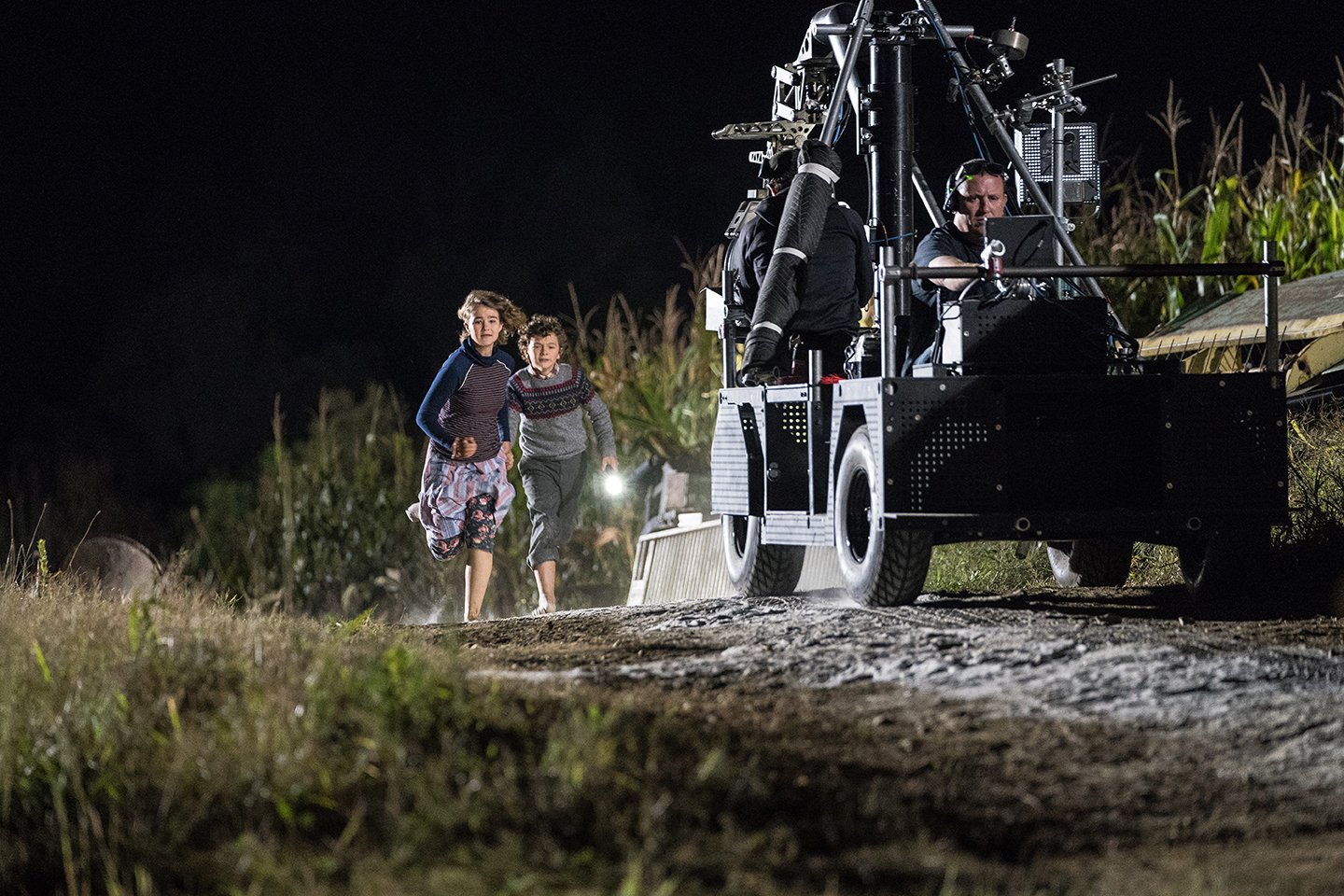
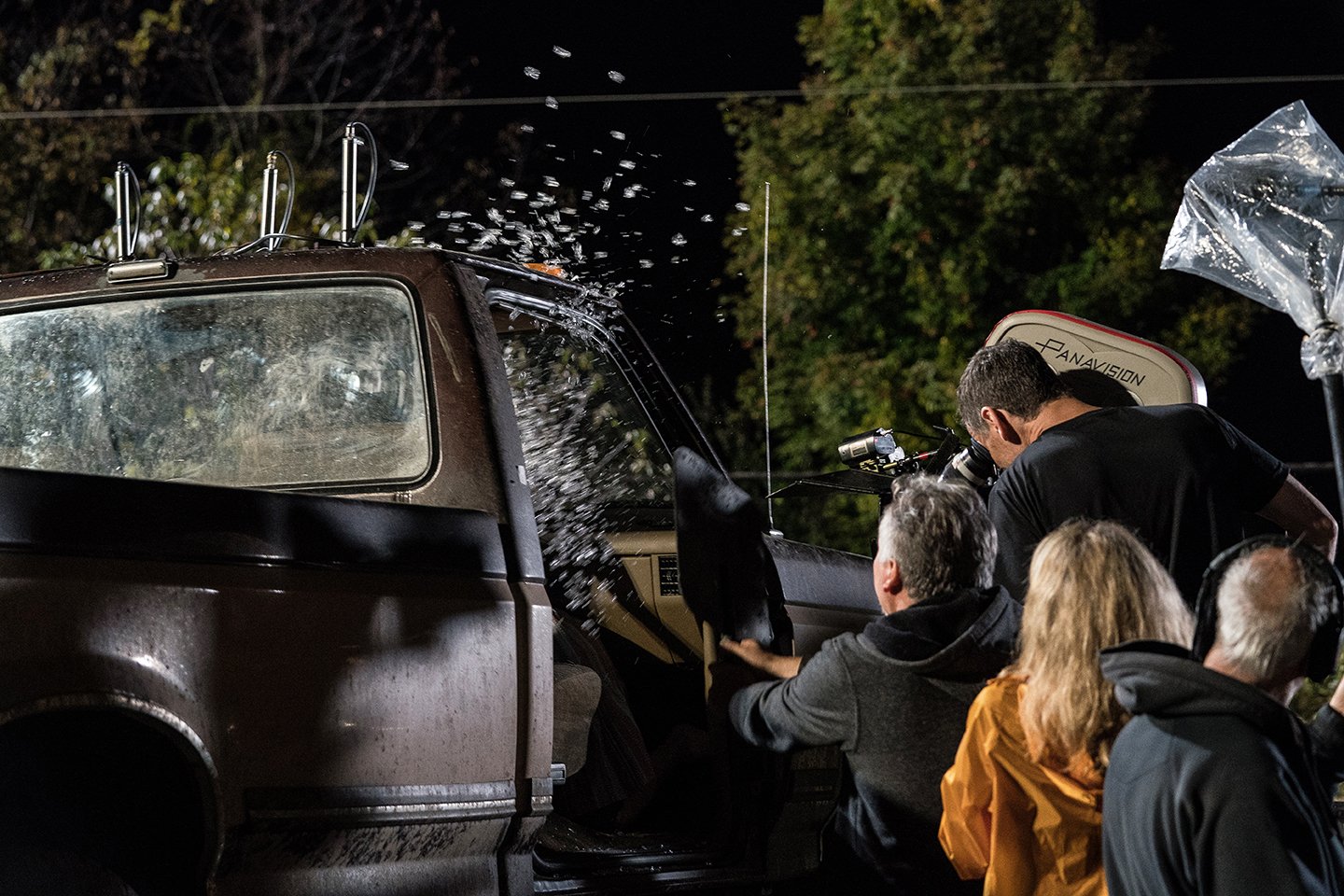
“B-camera 1st AC Paul Colangelo did a remarkable job pulling focus on those shots,” Emmerichs continues, “especially when you consider the fact he was running down a parallel row of corn and could barely see us. And, of course, he had to try and remain upright as well.”
Christensen and her team were on a 50' Technocrane for parts of the cornfield sequence. The Angenieux 15-40mm and 28-76mm zooms were used for most of the film’s night-exterior crane shots, of which there were many. “That particular cornfield sequence is one long scene with many different parts,” she says. “I was able to get big, wide shots across the field, showing where on the farm the different characters were. I was also able to follow each individually [within] the cornfield.” The production also employed a 30' Technocrane and a MovieBird for select scenes.
Nearly all footage for A Quiet Place was shot on practical locations. The Abbott property included a farmhouse, a barn, cornfields, a grain silo and a tractor shed. The barn and the silo — the latter of which was a meticulous replica, as “there was no silo at the spot we wanted it on the farm,” Christensen says — bookended the property, with the cornfields between them.
“We wanted to get off the ground, just to lift the audience out of the crazy situation these people were in. The feeling of being up high seemed important.”
Creating moonlight that spanned the entire farm at night was “a bit daunting at first,” Almeida admits. “When I came onboard, Charlotte and I walked around the entire site. A farm at night is pitch-black! And there was a lot of very rough terrain. We used five generators and a lot of cable — much of it buried — to power up the space. I felt the HMI Bebee Light was the best tool to use. We had two of them; they were our ‘moonlight.’ Luckily, a road completely surrounded the farm and I was able to quickly place the lights almost anywhere along the perimeter. We gelled them with 1⁄2 CTO and used medium to small HMIs around the cameras to provide light more locally. The Bebees are great because you can individually focus each of the 15 6K heads anywhere you like. You can also dim them or flood-spot each head. They gave us so much flexibility.”
Emmerichs recalls another particularly difficult night shot in the dense cornfield — a 180-degree wrap around Lee. “Charlotte lit the scene beautifully, using the two Bebee lights and a few lamps in lifts. It was a really nice wrap around John as he stood on a tractor, watching his worst nightmare approach through the cornfield.”
The film’s numerous crane shots offered psychological as well as visual benefits. “We wanted to get off the ground, just to lift the audience out of the crazy situation these people were in,” Christensen explains. “The feeling of being up high seemed important. Furthermore, in order to work safely, [especially] with the kids, we built several on-stage sets for the scenes on the top of the silo — and to reach into those sets, we needed the range of the arm.
“I had an absolutely fabulous key grip, Kevin Lowry,” the cinematographer adds. “He handled all the grip work, cranes, and the huge blackouts of the barn. Thanks to [his organizational skills], we managed to stay flexible with the ever-changing schedule, despite the fact that those key tools were booked to serve shots on specific days. [The barn] was a practical location, and because of the kids and the schedule, we had to shoot some interior barn scenes day-for-night. Kevin and his team did an amazing job making this happen. The schedule was a real challenge, and the teams — Kevin and the grip department, Bill Almeida and lighting, and the hardworking camera team led by Stanley Fernandez Jr. — did incredible work, ‘flexing’ in and out of different camera modes and locations to be ready and deliver precise work in a very short time. We simply wouldn’t have made the schedule and days without their expertise and patience.”
Only a handful of locations in the script required the building of sets. “A beautiful horse farm [was located] about a mile up the road, with a huge indoor riding arena,” says Christensen. “The place was empty. The construction team removed all the sand on the ground and replaced it with boards, and that floor became our stage. That was where they built the ‘safe room,’ which the Abbotts had dug underneath their barn.”
A particularly ambitious construction task was the re-creation of certain elements of the full-size six-story silo. These elements were also built on the horse-farm property, and served as the location for several scenes, including a sequence featuring Lee sitting on top of it, gazing back at the farmhouse and barn just as the sun is setting. It ended up being one of Krasinski’s favorite scenes in the film. “All the handheld work for this scene was shot on stage,” Christensen says. “The wider shots of John actually sitting on top of the real 60' silo were achieved on location, shot from two lifts.”

The director notes, “The farm plays such an important role in the movie. I didn’t want to cheat that, so we built an exact replica of a grain elevator. We put [one camera on a giant scissor lift and the other on a condor], and raised them to the top of it. You could see the entire farm. Instead of locking off one of the cameras, David suggested, ‘Why don’t I ride one of the lifts and try to keep the camera steady?’ It was a fabulous shot.”
For a sequence in which Marcus falls into the silo trying to escape the creatures, there is an exterior shot of him falling in and an interior shot of him inside the storage container. “We built two separate sets,” Almeida recounts. The first was “just the top of the silo, maybe 8' or 10' high. The exterior night scene was shot against ‘black limbo,’ [comprised of] black solids that the grips hung. The idea was that it was enough to pass as a real night sky with minimal visual-effects work. The day scenes on the same set required the use of greenscreen [that would be] replaced with a real day sky. To backlight those scenes, we used a couple of condors with HMI lights [in combination] with 8' by 8' and 12' by 12' Ultrabounces around camera to fill and key the scene.
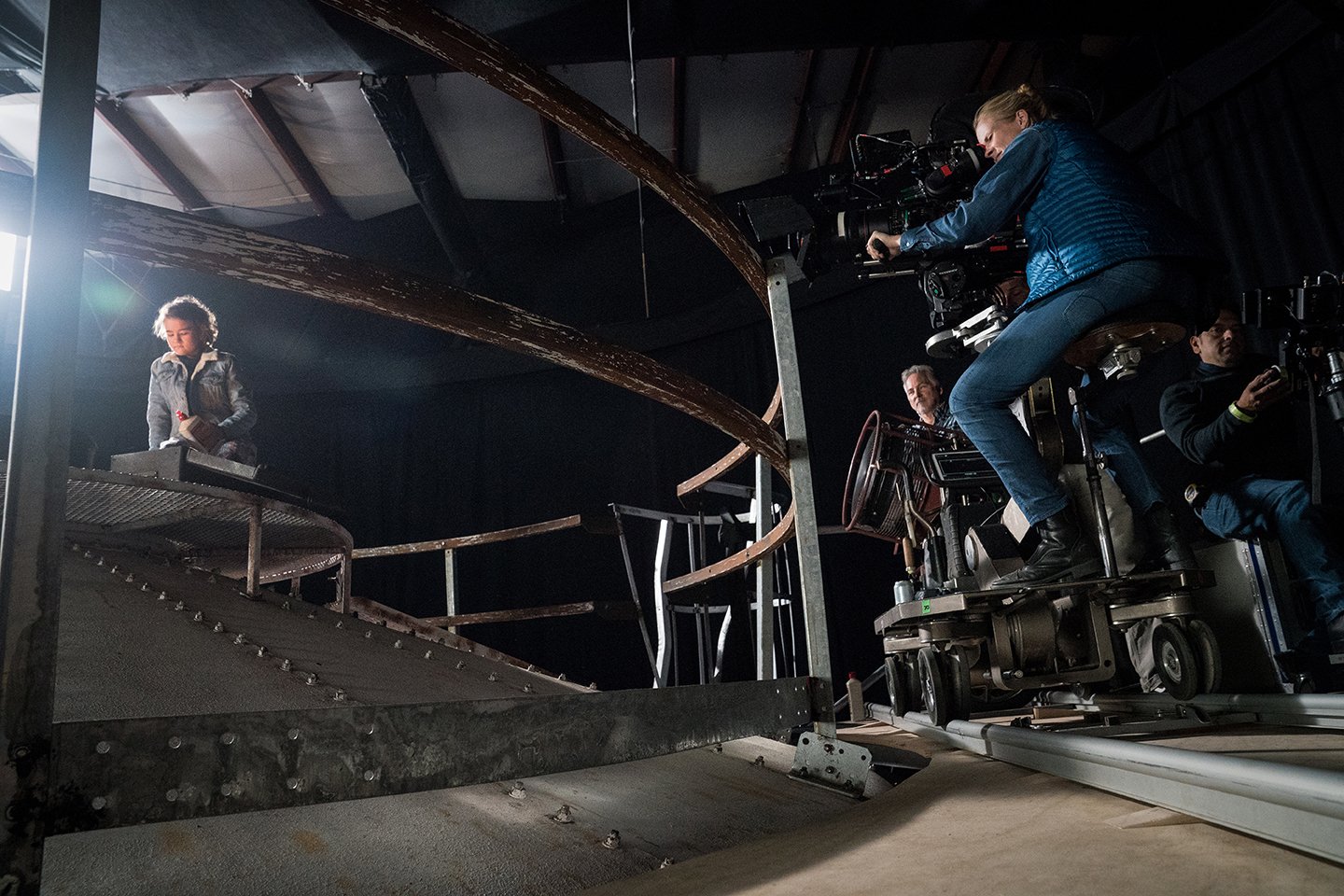
“The interior silo set was a bit trickier,” Almeida concedes. “The scene takes place at night and our only [motivating] light sources were moonlight and the boy’s flashlight. Making things far more difficult, however, was the presence of an irrigation system that ran right through the top of the set; it was used in the riding arena to stamp down the dust. We had to use a 4' by 4' mirror to get around it and to light from; we bounced light back to create moonlight coming through the silo’s top hatch, using Arri M40 HMIs with 1⁄2 CTO.”
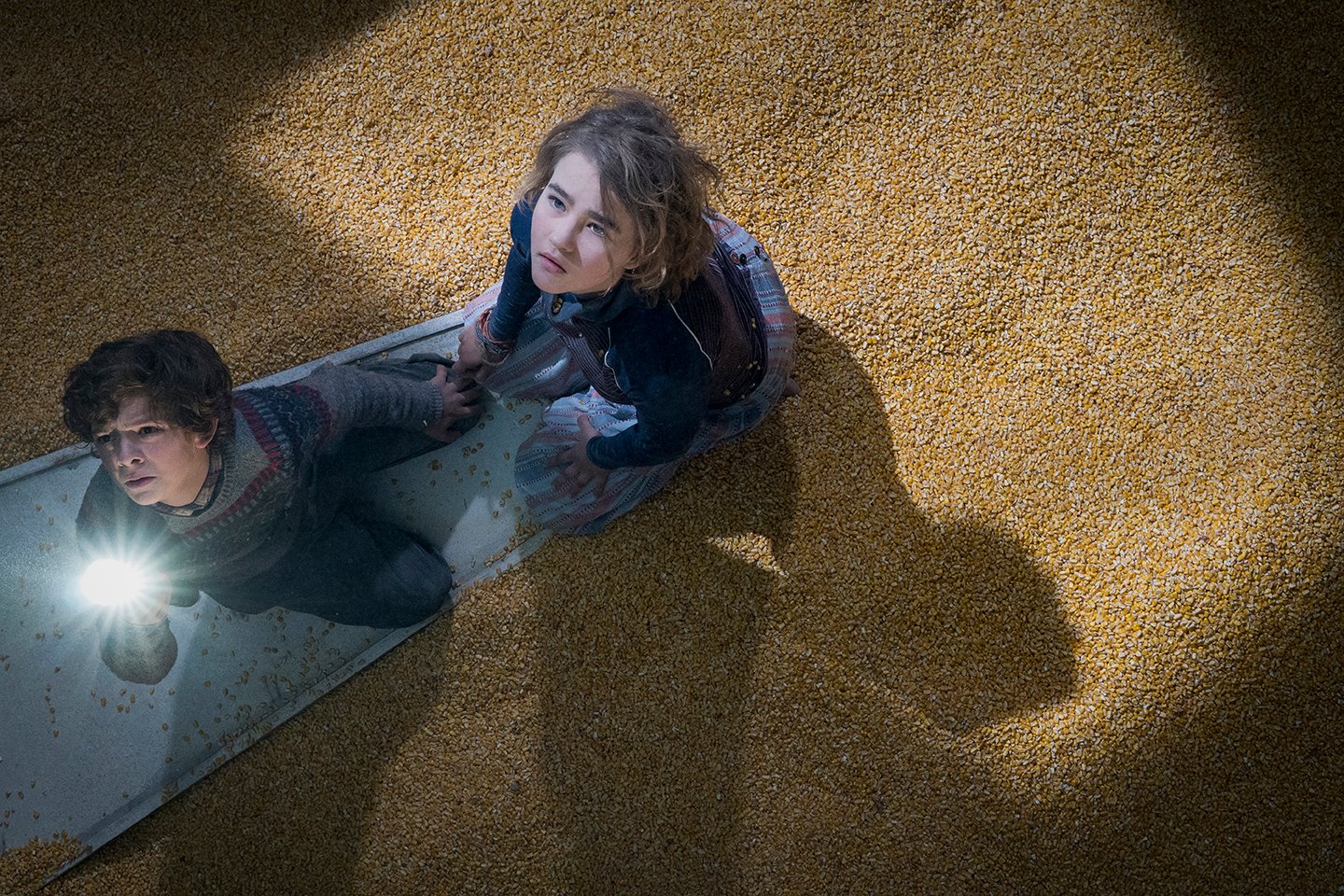
Christensen credits production designer Jeffrey Beecroft and his team for the set builds.
The production’s 2nd unit handled a lot of the pickup work around the farm, including beauty shots of the farm and surrounding area. Emmerichs also shot “a lot of effects sequences for the encounters with the creatures, which amounted to interactive visual-effects plates,” he notes. “ILM’s Farrar directed those sequences. We also did an amusing bunch of shots with some occasionally cooperative raccoons.
“I love lighting on film, I love the fact you have to use a light meter, and I love the way you are actually on the set and don’t disappear into a video tent.”
“I think I speak for the whole team when I say that Charlotte is one of the best-prepped cinematographers I have ever worked with,” Emmerichs adds. “She did a really effective lighting job in a very short amount of time, even testing how the corn would look when lit from different angles.”
For her part, Christensen raves about the crew, most of whom she had never worked with before. “Bill is amazingly calm and focused, Lowry is a fabulous grip, David was a tremendous support — everything you could want in a cinematographer colleague. Stanley was very tuned-in; when you switch between anamorphic and spherical lenses, it’s not just changing lenses — you have to change the ground glass, among other things in the camera.
“I know I’m saying they were all brilliant, but they truly were!” Christensen acknowledges with a laugh. “And I must mention [Panavision marketing executives and ASC associates] Sal Giarratano and David Dodson, whom I conferred with from the very beginning. And Dan Sasaki is a master. He really understands what is needed for every story. He came up with great ideas I never would have thought of.”
Reflecting on the decision to shoot on film, Christensen concludes, “John and I were both eager to create that cinematic look. Personally, I love the medium. I love lighting on film, I love the fact you have to use a light meter, and I love the way you are actually on the set and don’t disappear into a video tent.”
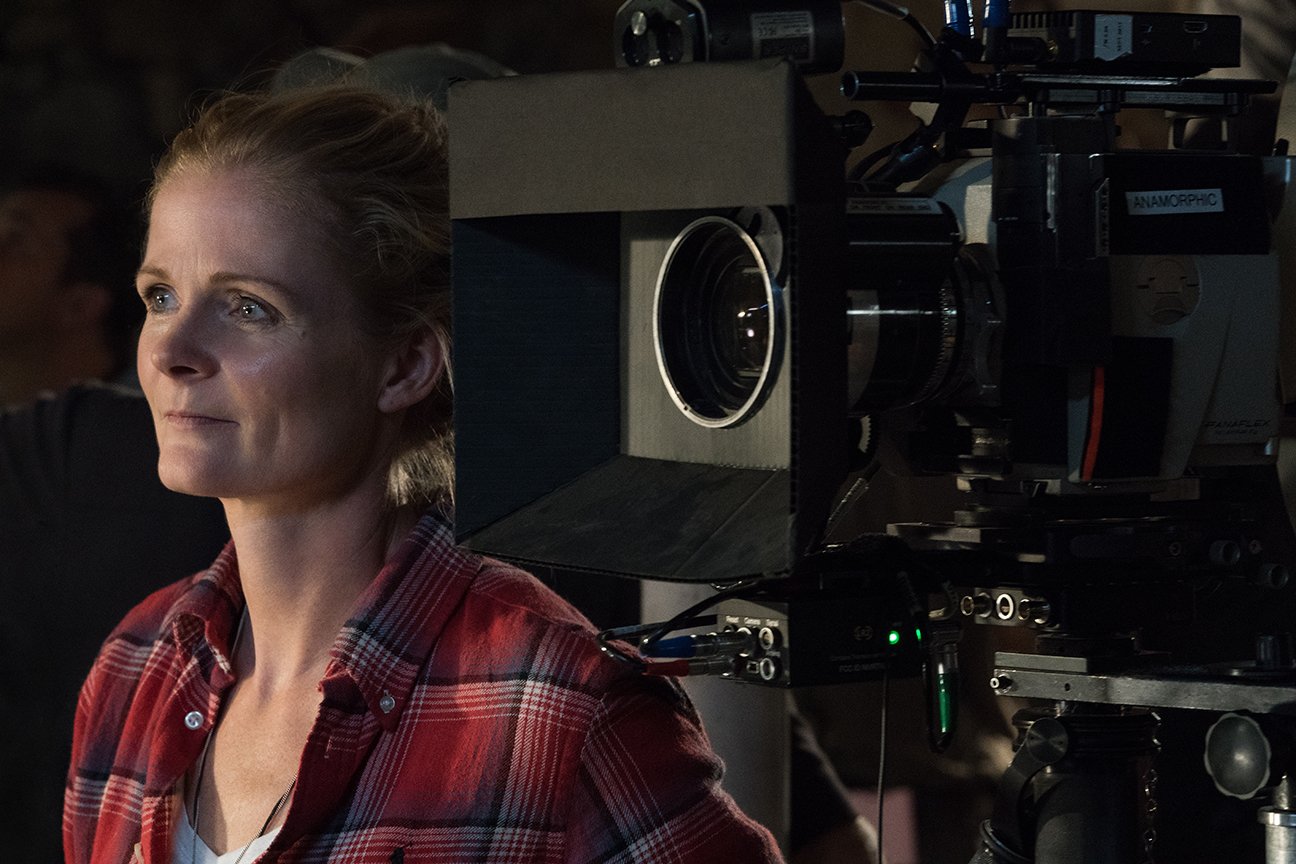
Optics Spotlight: Modified Lenses
To obtain the look and feel director John Krasinki wanted for the horror thriller A Quiet Place, cinematographer Charlotte Bruus Christensen suggested building the story in an anamorphic environment and switching to spherical lenses for night exteriors — and for the very tight close-ups of Regan, the pivotal character whose deafness holds the key to the murderous creatures who hunt their human victims by sound. Similar close-focus work was needed for such objects as Regan’s hearing aid and pieces being moved on a Monopoly board.
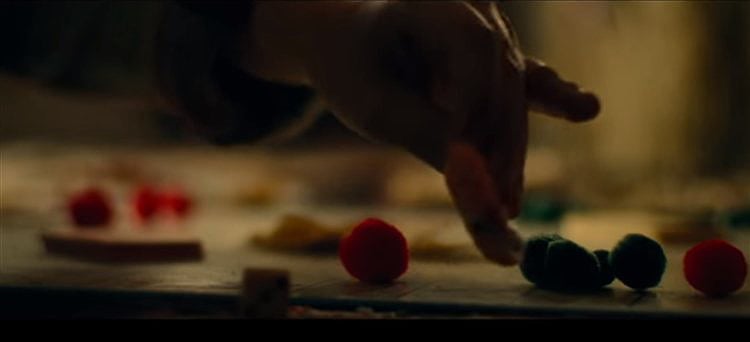
“We [used C, G and T Series] anamorphic primes to get the vintage-y look Charlotte wanted, then modified them for even closer work,” says ASC associate Dan Sasaki, Panavision’s vice president of optical engineering. “The Panavision C Series 65mm [already existed with a minimum] focus of 15". This lens became the standard into which we pulled/modified the other close-focus C Series.
“To achieve [the Monopoly-board shot],” he adds, “we had to build Charlotte a special periscope that put the lenses on the front in order to get her down to the game board at the angle she needed.
“Charlotte loved the way the anamorphics flared, so we tried to give the spherical lenses the same flare characteristics. We made an attachment that gave them similar speed and bokeh. Charlotte is very sensitive to barrel distortion and falloff; she wanted the anamorphics, especially the wide lenses, similar to what we had done together on Fences (AC Jan. ’17) and Molly’s Game, so basically I did the same application.
“To create the sense of isolation that Regan feels in a hearing world,” Sasaki adds, “we tried to make the anamorphic lenses go out of focus a bit faster — to limit the range of focus.” — Jean Oppenhheimer






